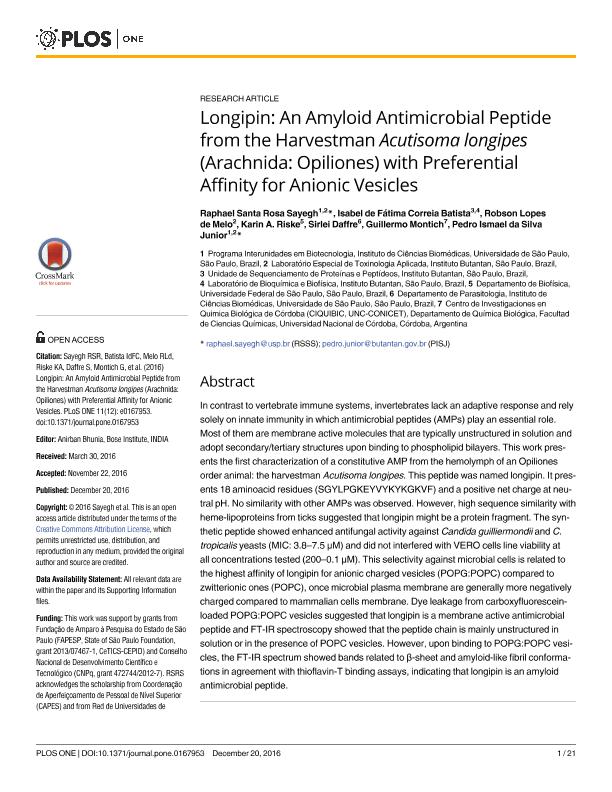Mostrar el registro sencillo del ítem
dc.contributor.author
Sayegh, Raphael Santa Rosa
dc.contributor.author
De Fatima Correia Batista, Isabel
dc.contributor.author
De Melo, Robson Lopes
dc.contributor.author
Riske, Karin A.
dc.contributor.author
Daffre, Sirlei
dc.contributor.author
Montich, Guillermo Gabriel

dc.contributor.author
Da Silva Junior, Pedro Ismael
dc.date.available
2018-08-28T18:35:26Z
dc.date.issued
2016-12
dc.identifier.citation
Sayegh, Raphael Santa Rosa; De Fatima Correia Batista, Isabel; De Melo, Robson Lopes; Riske, Karin A.; Daffre, Sirlei; et al.; Longipin: An amyloid antimicrobial peptide from the harvestman Acutisoma longipes (Arachnida: Opiliones) with preferential affinity for anionic vesicles; Public Library of Science; Plos One; 11; 12; 12-2016
dc.identifier.uri
http://hdl.handle.net/11336/57385
dc.description.abstract
In contrast to vertebrate immune systems, invertebrates lack an adaptive response and rely solely on innate immunity in which antimicrobial peptides (AMPs) play an essential role. Most of them are membrane active molecules that are typically unstructured in solution and adopt secondary/tertiary structures upon binding to phospholipid bilayers. This work presents the first characterization of a constitutive AMP from the hemolymph of an Opiliones order animal: the harvestman Acutisoma longipes. This peptide was named longipin. It presents 18 aminoacid residues (SGYLPGKEYVYKYKGKVF) and a positive net charge at neutral pH. No similarity with other AMPs was observed. However, high sequence similarity with heme-lipoproteins from ticks suggested that longipin might be a protein fragment. The synthetic peptide showed enhanced antifungal activity against Candida guilliermondii and C. tropicalis yeasts (MIC: 3.8-7.5 μM) and did not interfered with VERO cells line viability at all concentrations tested (200-0.1 μM). This selectivity against microbial cells is related to the highest affinity of longipin for anionic charged vesicles (POPG:POPC) compared to zwitterionic ones (POPC), once microbial plasma membrane are generally more negatively charged compared to mammalian cells membrane. Dye leakage from carboxyfluoresceinloaded POPG:POPC vesicles suggested that longipin is a membrane active antimicrobial peptide and FT-IR spectroscopy showed that the peptide chain is mainly unstructured in solution or in the presence of POPC vesicles. However, upon binding to POPG:POPC vesicles, the FT-IR spectrum showed bands related to β-sheet and amyloid-like fibril conformations in agreement with thioflavin-T binding assays, indicating that longipin is an amyloid antimicrobial peptide.
dc.format
application/pdf
dc.language.iso
eng
dc.publisher
Public Library of Science

dc.rights
info:eu-repo/semantics/openAccess
dc.rights.uri
https://creativecommons.org/licenses/by-nc-sa/2.5/ar/
dc.subject
Amyloyd
dc.subject
Antimicrobial
dc.subject
Peptide
dc.subject
Vesicle
dc.subject.classification
Otras Ciencias Biológicas

dc.subject.classification
Ciencias Biológicas

dc.subject.classification
CIENCIAS NATURALES Y EXACTAS

dc.title
Longipin: An amyloid antimicrobial peptide from the harvestman Acutisoma longipes (Arachnida: Opiliones) with preferential affinity for anionic vesicles
dc.type
info:eu-repo/semantics/article
dc.type
info:ar-repo/semantics/artículo
dc.type
info:eu-repo/semantics/publishedVersion
dc.date.updated
2018-08-27T18:55:12Z
dc.identifier.eissn
1932-6203
dc.journal.volume
11
dc.journal.number
12
dc.journal.pais
Estados Unidos

dc.journal.ciudad
San Francisco
dc.description.fil
Fil: Sayegh, Raphael Santa Rosa. Universidade de Sao Paulo; Brasil. Governo do Estado de Sao Paulo. Secretaria da Saude. Instituto Butantan; Brasil
dc.description.fil
Fil: De Fatima Correia Batista, Isabel. Governo do Estado de Sao Paulo. Secretaria da Saude. Instituto Butantan; Brasil
dc.description.fil
Fil: De Melo, Robson Lopes. Governo do Estado de Sao Paulo. Secretaria da Saude. Instituto Butantan; Brasil
dc.description.fil
Fil: Riske, Karin A.. Universidade de Sao Paulo; Brasil
dc.description.fil
Fil: Daffre, Sirlei. Universidade de Sao Paulo; Brasil
dc.description.fil
Fil: Montich, Guillermo Gabriel. Consejo Nacional de Investigaciones Científicas y Técnicas. Centro Científico Tecnológico Conicet - Córdoba. Centro de Investigaciones en Química Biológica de Córdoba. Universidad Nacional de Córdoba. Facultad de Ciencias Químicas. Centro de Investigaciones en Química Biológica de Córdoba; Argentina
dc.description.fil
Fil: Da Silva Junior, Pedro Ismael. Governo do Estado de Sao Paulo. Secretaria da Saude. Instituto Butantan; Brasil. Universidade de Sao Paulo; Brasil
dc.journal.title
Plos One

dc.relation.alternativeid
info:eu-repo/semantics/altIdentifier/doi/http://dx.doi.org/10.1371/journal.pone.0167953
dc.relation.alternativeid
info:eu-repo/semantics/altIdentifier/url/http://journals.plos.org/plosone/article?id=10.1371/journal.pone.0167953
Archivos asociados
